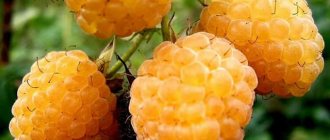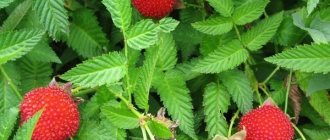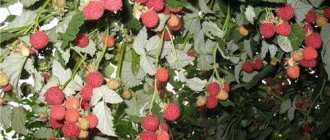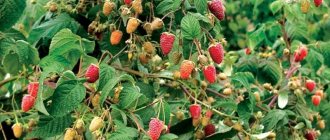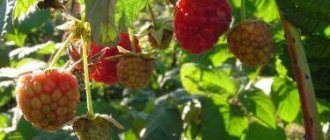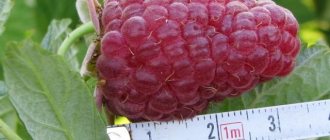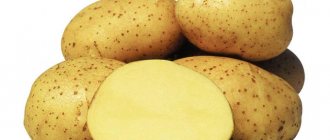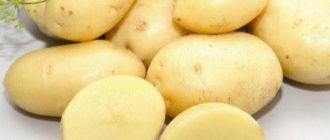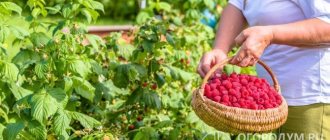Raspberries are not only tasty, but also healthy berries with many healing qualities. Growing a raspberry variety like Gusar requires special attention, because in winter it can freeze. In unfavorable conditions, the quality and volume of the harvest decreases, the plant is exposed to various types of diseases and is affected by pests.
raspberry variety "Gussar"
variety "Gussar" is responsive to watering and fertilizer, producing berries for a long period
raspberry “Gussar” is perhaps the best domestic variety in terms of the amount of positive economically valuable properties
How did breeders create the Gusar variety?
In 1999, breeder Kazakov obtained a raspberry variety, which he gave the name “Gussar”. Raspberry Gusar is successfully grown in any Russian region, but initially it was planned to cultivate the crop in the North Caucasus.
This variety is considered frost-resistant, as it can easily tolerate temperatures of -40˚C for a long time. Raspberries are not afraid of dry weather and can grow in open areas and soils with low fertility.
It is recommended to grow this raspberry variety in the Central, North-Western, North Caucasus, Middle Volga and Volga-Vyatka regions. Also suitable for cultivation in Ukraine and Belarus.
Some unscrupulous sellers claim that this is a remontant raspberry variety, relying on the fact that the Gusar raspberry was bred by Ivan Vasilyevich Kazakov himself, known as the creator of remontant raspberry varieties. And you can believe in this and be deeply mistaken... Indeed, the famous breeder is the author of this variety, but the Gusar raspberry has the usual type of fruiting, it is not remontant (see Kazakov I.V., Evdokimenko S.N. “Remontant raspberry.” - Moscow, 2007).
Description of the variety
The variety was included in the State Register in 1999 with permission for use in the Central, Middle Volga, Volga-Vyatka, North-West and North Caucasus regions. For remontant raspberries, unlike conventional varieties, not only two-year-old shoots, but also one-year-old shoots bear fruit. During the season you can get a harvest twice - in summer and autumn.
Gusar is an early ripening raspberry, so it has time to fully ripen during the sunny period and produce the main harvest before the cold weather. Gardeners who cultivate this variety speak of it with admiration. In one place, a berry bush bears fruit well for 20 years. A pronounced waxy coating on the shoots protects them from excessive evaporation of moisture and makes the plant drought-resistant. Possessing frost resistance, Gusar can withstand temperatures down to -25 °C.
Among the advantages of this raspberry is immunity to major diseases. There are practically no wormy berries on it, and it is rarely affected by weevils and gall midges. And due to the absence of abundant root shoots, the crop does not fill the garden space and directs all its forces to the formation of a harvest.
Raspberry Gusar is a remontant variety and can bear fruit twice per season.
Distinctive features of the Gusar raspberry
The Gusar variety is very popular among gardeners. And this is not surprising, because raspberries have received truly valuable qualities:
- Powerful stems, thanks to which it can easily withstand even strong gusts of wind. If ideal conditions are created, the bush grows up to 3 m in height.
- The fruits are large, the average berry weight is about 3 g, but there are fruits weighing up to 12 g. You can get about 15 kg of tender raspberries from just one bush, but subject to high fruitfulness.
- The berries have a conical shape; upon reaching full ripeness they become tender and sweet, with a slight sourness. Raspberries contain a large amount of vitamin B6, C, K.
- Fruiting branches are located along the surface of the shoot.
- The leaves are slightly drooping, slightly wrinkled, and have a rich dark green color.
- The fruits are scarlet in color, with a ruby tint. There is a pronounced berry aroma.
- The culture tolerates drought and low temperatures well.
- It is highly resistant to various fungal and viral diseases.
- The percentage of sugar in berries does not exceed 10.9. Berries contain about 37% vitamin C.
The gardener presented the “Gussar” raspberry variety for review in the following video:
Trimming
Pruning is a necessary procedure for raspberries, which is carried out three times: in spring, summer and autumn.
- After fruiting, the shoots are shortened by 50-60 cm. The side shoots are removed.
- In autumn, root shoots and injured and diseased shoots are removed. In northern latitudes, bushes are trimmed completely. In the southern regions, 2 shoots are left, then next summer both will bear fruit.
- In the spring, the plants are shortened to the first strong and healthy bud. Branches damaged by frost are removed.
The cut branches are taken outside the site and disposed of. The raspberry plant must be kept clean so as not to provoke the occurrence of diseases or pests.
It is believed that pruning Gusar raspberries at the root in winter guarantees an excellent harvest in the spring.
Advantages and disadvantages
Raspberry Gusar is one of the best varieties. It has become so popular among gardeners due to its many advantages.
The main advantages of Gusar raspberries are:
- large berries of rich red color;
- pleasant berry taste with slight sourness;
- the pulp is tender and aromatic;
- All berries ripen in just 1 month;
- bushes grow quickly and can reach almost 3 m in length;
- there are practically no thorns on the stem, they are located in the lower part, so there are no difficulties when harvesting;
- the fruits are universal in use;
- the variety is drought-resistant, so it is grown even in hot areas, and drought does not affect the quality and volume of the harvest;
- the leaves and stems are slightly reddish in color; on their surface there is an almost imperceptible layer of hairs, which protects against dryness and other types of harmful effects from the environment.
With proper and regular care, you can collect 10-15 kg of juicy berries from one raspberry bush.
Despite its positive qualities, the Gusar variety also has a number of disadvantages, including:
- The berries are too soft and not dense, so they cannot be stored for a long time.
- The softness of the berries does not allow the fruit to be transported, as there is a risk of losing the harvest.
- Raspberry Gusar needs careful and constant care; it also requires a large area for its cultivation.
- The variety is frost-resistant, but the root system must be protected. Otherwise, the raspberries will simply die during frost.
Characteristics
Raspberry Gusar is a tall variety, reaching a height of 2-2.5 m. The shrub has powerful, erect shoots and large leaves. This variety does not need to be tied to supports. It does not bend or break even in heavy winds and excessive precipitation, thanks to its powerful stems.
The stems of the Gusar variety are not pubescent, covered with a dense waxy coating. A few thorns are located only in the lower part of the shoots, which is a distinctive characteristic and greatly facilitates the collection of berries.
Advice! In case of a bountiful harvest and intensive growth of bushes, it is necessary to take care of tying.
The fruits have distinctive features:
- the shape of the berry is cone-shaped, with a blunt tip;
- color – bright ruby;
- taste – sweet and sour;
- weight not less than 3 g, with intensive care and favorable conditions reaches a weight of 10 g;
- sugar content – up to 11%.
The berries hold tightly to the stalks, do not fall off, and are easily transported. The universal variety is characterized by high yield, up to 6 kg per bush.
Preparing for landing
Before purchasing Gusar raspberry seedlings, you need to think about where it will be planted. It is important to choose a place that is not too dark and moderately sunny.
The area should be protected from the winds, so that the raspberries will grow quickly and will soon produce a large harvest.
Planting material
In order for the raspberry tree to grow well and produce a high-quality harvest, it is necessary to choose the right seedling.
Follow these guidelines:
- The seedling must have only 1 shoot.
- At the base, the shoot should be no more than 1 cm in volume.
- The length of the upper stem is no more than 45 cm, the rhizome is no less than 15 cm.
- Purchase seedlings only from trusted and specialized garden stores to be sure of the high quality of planting material. Low quality plants die even before they produce their first harvest.
- Do not purchase a seedling with visible external damage, or if it does not correspond to the main characteristics of the variety.
You cannot choose for planting seedlings on which the leaves have already fully opened, since the plants will not take root, will constantly get sick and will die as a result.
Territory for raspberry fields
Raspberry Gusar does not have high requirements for soil composition, so seedlings easily and quickly take root in almost any area.
To get maximum yield and enjoy aromatic and juicy berries, choose a good place for the crop.
The tips are:
- Choose an area where you plan to grow raspberries that will have sufficient light during the day. Growing in the shade, shrubs develop poorly and will not be able to become strong enough to survive the winter safely.
- The ideal place for a raspberry plant would be a flat area, but a slight slope is also allowed.
- Make sure that the groundwater level does not exceed 1.5 m to the surface, since waterlogging is prohibited for raspberries. Neglecting this advice may lead to the death of the plant.
- The quality of the soil in the selected area is also important. The ideal option would be soil that has good air permeability. The acidity level should not be higher than pH 6.
- Do not plant the crop on soils where potatoes, strawberries, carrots or eggplants grew last year. Sources of diseases, as well as pest larvae remaining in the ground, will cause serious harm to the future raspberry tree.
Tillage
The garden crop thrives on light loamy or sandy soils.
It is important to choose soil with neutral acidity. The culture takes root well in clayey areas.
The soil should not be over-moistened, as too high humidity leads to rapid growth of the bush and poor formation of fruit ovaries. That is why it is recommended to enrich clayey areas additionally - by 1 sq. m take 1 bucket of sand. Acidic soil needs to be limed: per 1 sq. m - 500 g of lime.
Landing dates
Gusar raspberries can be planted in spring or autumn. If the choice falls on the spring season, it is important that the temperature does not drop below 0°C during the week. The ideal option would be a positive temperature, since the soil should have time to warm up well before planting.
When planting raspberries in the spring, do not expect abundant fruiting, as the plant will use all its strength to take root well in its new location.
The most suitable time for planting raspberries is considered to be autumn, but no later than 20 days before the onset of frost. In this case, the seedlings will have time to take root in a new place, take root and be well prepared for the beginning of winter. Already in the spring, raspberries will devote all their strength not only to the formation of shoots, but also to the volume of the harvest.
Landing rules
In order for the Gussar raspberry to produce a sufficiently large harvest, it must be planted correctly. It’s worth taking a closer look at what exactly this requires.
Place and soil
You need to choose the right place for planting so that the culture feels normal and develops well. Here are the basic requirements:
- neutral soil acidity;
- lack of groundwater under the raspberry tree;
- sunny side;
- loamy or sandy soil.
These are the basic requirements that you need to remember when planting raspberries.
When to plant?
Today, gardeners plant Gusar raspberries in the fall or spring. This is the optimal period, since the plant is ready for a state of dormancy or, conversely, for active growth.
Here are the main advantages of planting in spring:
- the bush is ready for active growth;
- the plant will approach winter with a developed root system and will be able to survive the cold well;
- Having tasted the berries, you can understand how necessary this variety is on the site.
Here are the advantages of autumn planting:
- savings on fertilizers, since young roots do not need many nutrients;
- hardening of the plant;
- in the spring, the shoots immediately begin active growth without the need to waste time on acclimatization.
Thus, each gardener must decide for himself: at what time is it best for him to plant. If the seedlings appeared in the summer, they must be preserved until autumn, and then planted.
Correct landing: step-by-step instructions
Raspberries can be planted in several ways - trench, strip or artisanal.
In any case, organic fertilizers must be additionally used. Humus is an excellent choice, and rotted manure is also suitable. To prevent the roots of the seedling from coming into contact with fertilizers, they need to be additionally sprinkled with earth, which will help avoid burns.
Before planting, the seedlings are placed in water and left for 2 hours, thanks to which they gain strength and quickly get used to the new place.
The trench planting method is carried out as follows:
- Dig a fairly long trench, at least 20 cm deep.
- Fill the trench with water so that it is evenly distributed.
- Add pre-selected fertilizers.
- Carefully place the seedlings, with a distance of at least 50 cm between them.
- Sprinkle the raspberries lightly with soil. Do not forget to hold the seedlings, as they need to be fixed in a vertical position.
- Tamp down the soil a little.
- After planting all the seedlings, be sure to water them.
To calculate the required trench length, consider the number of seedlings, as well as the distance that should remain between them during planting.
The tape planting method is very simple to implement; just follow these tips:
- Dig several holes in one row at once, taking into account how many seedlings will be planted.
- Leave a distance of approximately 30-40 cm between the holes.
- The width of the pit should be 40 cm and the depth 50 cm.
- If you plant several rows of seedlings at once, leave a distance of 2 m between each one.
- Place pre-prepared fertilizers into each hole, filling it about halfway, and sprinkle a little soil on top.
- Place the seedlings in the planting hole and carefully straighten the roots.
- Hold the seedlings vertically, add soil and compact them a little, but not too much, so as not to damage the roots.
- Do not allow seedlings to go deep into the ground - the root buds should be above the soil surface. Neglecting this advice may trigger the onset of rot.
- Water the seedlings: for each cutting - 1 bucket of water.
Planting Gusar raspberries using the artisanal method is carried out according to the following scheme:
- Dig planting holes, leaving a distance of about 1-1.5 m.
- The depth and width of the pit should be 50 cm.
- Add fertilizer, don't forget about water.
- Divide the seedlings in groups of 10 pieces.
- Place 10 seedlings per planting hole.
- Add enough soil so that the root buds are on the surface.
- Lightly compact the soil.
- Be sure to water each plant, which will speed up their rooting.
Planting and growing
In order for the variety to delight you with aromatic berries already in the first year of planting, it is necessary to take into account certain nuances.
The culture prefers soils with a neutral pH level. Acidic soils have a negative effect on it. If the bush grows in the shade, this also contributes to a drop in yield. Sunlight is needed to maintain metabolism. Make sure that the planting site is protected from drafts. It is especially important to take care of this at the beginning of spring and at the end of autumn.
It is advisable to select areas where crops with various types of diseases have not previously grown, since bacteria can persist in the soil for a long time. Raspberries planted in such a place will soon be affected by them. It is strongly not recommended to plant raspberries where potatoes and carrots used to grow.
Dig the trench or holes in advance. It is recommended to do this 4 weeks before planting the seedlings.
There are two ways to grow a plant:
- Trench. The seedlings are planted in a row using a ribbon. Trenches with a depth of 15 to 20 cm are constructed. After this, they are filled with water and organic fertilizers are sprinkled. Then the seedlings are planted in the soil.
- Artisanal. The stems are planted in groups of 10 so that in the future they form a kind of bush. There should be a distance of at least a meter between individual groups of such stems, otherwise it will be difficult to care for them.
Both the first and second methods are popular with our gardeners. You can decide for yourself which one is more convenient for you. In any case, there should be enough fertilizer to ensure that the bushes grow upright and their stems remain strong. An optimal supply of nutrients ensures good taste of the berries.
Fertilizers are placed in holes and trenches. They are taken at a rate of 2 kg per stem. After application to the soil, the trench is covered with soil 5 cm high. This is required to avoid direct contact of the fertilizer with the raspberry roots. If this happens, they will suffer serious damage, especially if there is a lack of moisture.
Do not ignore ammonia fertilizers, especially if you are replanting bushes. Ammonium nitrate promotes rapid plant growth and strengthening. It is enough to take 20 g for each bush. Relatively little time will pass and the plant will have new shoots.
Tips for caring for Gusar raspberries
To get a rich harvest every season, it is not enough to simply plant Gusar raspberry seedlings, taking into account all the rules and subtleties of this process.
This plant needs regular care, which consists of timely application of fertilizers, tying, watering, pruning and, of course, we must not forget about covering the plant for the winter, which helps prevent freezing in severe frosts.
Watering
Despite the fact that the crop tolerates dry periods quite well, the plant must receive regular watering, especially if the summer was dry. It is recommended to moisten the raspberry tree once every 7-9 days, observing the following proportions - 10 liters of water per bush.
You can use various watering methods - for example, simulating rain. Using a sprayer moistens the soil, air and foliage. However, this method of watering is strictly prohibited when fruiting begins, otherwise there is a risk of the berries starting to rot.
In most cases, watering is carried out through grooves, which must first be laid around the bushes or between the rows in the raspberry field. After watering, it is important to seal each furrow.
The drip irrigation method is also popular, during which special tapes with droppers are used. Water is supplied to these belts under high pressure. Using this irrigation method, optimal soil moisture is maintained and water consumption is reduced.
Before the onset of frost, watering is required, taking into account the consumption of 1 bush - 20 liters of water.
Supports
The use of supports when growing Gusar raspberries is not necessary. One of the features of the variety is its fairly strong stems. But during the period of fruit ripening, supports are additionally used. Thanks to the garter, the quality of the fruit improves.
With abundant fruiting, heavy weight puts increased pressure on thin stems. In this case, it is imperative to use supports that offer additional support to the plant.
Several different types of raspberry garter are used:
- Fan - hammer in supports on both sides of the plant stem. Carefully tie the stems at a short distance (about 5-10 cm). After gartering, the raspberry bushes will resemble a fan, hence the name.
- Trellis - hammer in supports along the entire perimeter of the raspberry tree, then pull a rope between them, on which the branches of the plant will be fixed. With this garter method, the bush will be erect.
Trimming
One of the most important points in caring for raspberries is pruning the bushes. The procedure allows you to increase the yield of the variety several times and has a positive effect on the appearance of the garden.
The pruning rules are:
- Begin the pruning procedure after the entire crop has been harvested, as well as in early spring, when frosts have subsided.
- When pruning raspberries after fruiting, remove about 30 cm, cut off all branches that did not have berries. Read about proper pruning of raspberries in the fall here.
- With the arrival of spring, remove all unnecessary branches that make the bush seem too dense.
- Trim fruiting shoots at a level of about 20 cm above the ground.
- If you shorten the branches too much, do not worry, as raspberries grow very quickly and the appearance of the first lateral branches easily compensates for the short height of the stem.
By removing excess branches, there will be no difficulties during harvesting.
Loosening and weeds
When growing Gusar raspberries, remember that the variety needs constant loosening of the soil. This simple procedure gives access to the maximum amount of valuable nutrients to the root system, which is why the raspberries develop faster.
Loosening is carried out to a depth of about 7 cm, but you need to act carefully so as not to harm the root system. A layer of humus and straw is placed on top of the soil.
It is important to regularly weed the raspberry tree to remove weeds. The grass choke the raspberries and the plant does not receive the required amount of nutrients. Weed once every 14-20 days.
Fertilizing and mulching
As soon as warm weather sets in, frosts have completely passed, and new leaves appear on the raspberry stems, start fertilizing.
Fertilizers are applied like this:
- When the soil thaws, apply rotted manure (no more than 1 bucket) on top of each bush.
- Use organic types of fertilizer first. Mullein is perfect, but it must first be diluted with water in a ratio of 1:5. You can take a solution of bird droppings with water (1:10). To fertilize each raspberry bush, use 1 liter of fertilizer.
- With the onset of the flowering period, carry out the 2nd feeding. Use the following mixture: potassium and phosphorus fertilizers (10 g each), with the addition of organic infusion (exactly 10 l).
- Carry out this procedure in the fall, as after the start of flowering. However, if the bush is very lush and actively developing, this procedure is not necessary, because there is a sufficient amount of nutrients in the soil.
- In summer, sprinkle wood ash between the rows of raspberries once every 2 weeks - per 1 square meter. m take 500 ml of ash.
Preparing for winter
When Gusar raspberries are grown as an annual crop, with the stems mowed, the bush tolerates winter cold without problems. It will be enough to cover the roots with mulch.
But gardeners in most cases choose the option of harvesting several times in 1 season. Therefore, with the onset of autumn, it is necessary to remove only those shoots that are several years old, and annual shoots must be covered.
Raspberry Gusar is a frost-resistant variety that easily tolerates winter and does not require additional insulation with snow cover. But if the winter is without snow and the plant grows in less than favorable conditions, there is a risk of the roots freezing.
To prepare the plant for winter, after pre-winter watering, mulch with humus. Bend the raspberry stems in an arc and attach them to a wire that you stretch along the row in advance. Cover the top with non-woven material, which will prevent the shoots from drying out. Cover the shoots no earlier than 1 week before the onset of frost.
Care, watering, garter, pruning, etc.
Watering must be done very often, despite the fact that the variety is drought-resistant and can withstand record temperatures. The more comfortable the raspberries “live”, the more they will please you with the harvest and quality of the berries. It is also worth remembering that abundant watering does not mean growing bushes like rice - constantly in water. Just make sure that the top layer of soil does not dry out. That is, in the spring-summer period you will have to water about 1-2 times a week.
As for the garter, it is not necessary, since Gusar is an erect plant and the stems are quite strong. But for greater aesthetics and purity of the berries, it would be better to make supports during fruiting, since under the heavy weight of the future harvest the stems can bend all the way to the ground.
There are 2 types of garters:
- Fan. To the left and right of the bush, supports (mostly sticks) are hammered into which branches are tied at a distance of 5-10 cm from one another. Thus, the plant resembles an ordinary fan.
- Trellis. Supports are hammered around the perimeter, a rope is stretched between them or boards are nailed to which branches are tied. The bush looks upright.
Pruning is one of the most important processes that affects the quality and quantity of your harvest, as well as the appearance of your garden. Raspberries need to be pruned after fruiting, as well as after winter. In the first case, it is shortened by 30-40 centimeters, shoots and non-fruit-bearing branches are cut out. In the second case, at the beginning of spring, all unnecessary shoots are removed, which create an increased density of the bush and have many branches, as well as fruit-bearing shoots up to the first healthy bud. They are often pruned at a height of up to 20 cm (sometimes more) above the ground, this depends on the location of the bud.
Don't be afraid to prune the shoots too much - raspberries grow very quickly and compensate for the lack of stem height with the number of fruits and side branches. If you want to get a big harvest and large fruits, constantly cut out unnecessary shoots, leave no more than 10-12 stems per bush.
Raspberry picking and storage
In early June, begin harvesting the first harvest of Gusar raspberries.
Try to carry out this procedure in dry weather: when there is no rain and the grass is completely dry. Otherwise, the berries will quickly deteriorate and the entire harvest will be lost.
Fully ripe berries have a rich red color. If the fruits begin to darken, it means they are overripe. This will not negatively affect the taste of the berries, but transportation will be very difficult. Carefully separate the berries and stalks, because the juicy pulp is easily damaged and the fruits turn into mush.
If you plan to transport raspberries, carefully trim the stalk without affecting the fruit. Try not to touch the berries themselves.
To harvest, take glass, dry and clean jars; containers in which the harvest will be transported are also suitable.
After completing the picking, be sure to place the berries in the shade so that under the influence of the sun they do not begin to sour or spread.
Store the harvest in the refrigerator for 2-3 days at a temperature of at least +5°C and humidity levels within 85%.
Try to quickly process the berries - prepare jam, berry jams or compotes; raspberries, grated with sugar, are very tasty (the ingredients are taken in equal quantities).
Diseases and pests, methods of control and prevention
According to reviews, the Gusar raspberry variety attracts weevils and stem gall midges. To prevent pests from spoiling the plant crop, gardeners spray raspberries:
- Bordeaux mixture;
- karbofos;
- diluted ammonia;
- bactophyte;
- decoctions of herbs wormwood, dill.
Important! The spraying procedure is carried out in early spring at the first leaf buds to bloom and in the fall at the time of pruning the bushes. Poisonous solutions will rid raspberries of pests and diseases.
Reproduction
This raspberry variety is propagated in several ways. The seed method is extremely rarely used, since it requires a lot of time and effort, and the main varietal characteristics may be lost.
Propagation by cuttings:
- In early summer, cut young shoots about 5 cm high underground and place them at an angle of about 45 degrees in the greenhouse.
- Ventilate and moisten the cuttings regularly.
- Rooting occurs in approximately 15 days.
- Fertilize using complex fertilizers.
- After a week, plant the cuttings in the garden, taking into account the 10x30 cm pattern.
- In autumn, transplant raspberries to a previously prepared place in the garden.
Raspberry Gusar reproduces quickly using root shoots:
- In summer, dig up shoots about 15 cm high along with the roots.
- Replant in a prepared area.
- You can propagate raspberries by dividing the bush - the bush is divided into parts.
- Cut each part to 45 cm, then plant it in separate branches.
Raspberries are also propagated using root cuttings:
- At the end of the season, cut the shoots into pieces about 10 cm long.
- Plant in a prepared area, do not forget to apply fertilizer in advance.
- Water the plantings and mulch the soil.
- For the winter, be sure to cover the shoots with pine paws.
- In spring, remove the pine paws and stretch the film on top.
- After the first green shoots appear, remove the film.
- Transplant the seedlings in the fall to a permanent location.
Planting berries
Selecting a location, planting dates and soil preparation
Raspberry bush in the forest
In the wild, raspberries grow on the banks of rivers, ravines, along the edges of swamps, in clearings, that is, in sunny places, sheltered from the winds by trees, on loose and moist, but not flooded soils. You need to find a similar area in your garden to plant a raspberry tree. The bushes should be exposed to the sun most of the day. In the shade, Gusar will not bear fruit, or the berries will grow small and sour.
Plant raspberries along the fence in one row so that each bush is well lit and ventilated.
Favorable periods for planting: spring - in April and autumn - after September 15. The root system of this crop is not as powerful as that of trees, so planting holes are not prepared in advance. It is enough to clear the area of debris and old plant debris, and to prevent diseases, treat the soil with a 1% solution of Bordeaux mixture (100 g per 10 liters of water).
It is better to dig up clayey and poor soil, adding per 1 m²:
- 1 bucket of compost or humus;
- 1 bucket of peat or 0.5 bucket of sand;
- 0.5 l of ash.
Video: Where to plant raspberries?
Selection of seedlings and planting
The most important part of a raspberry seedling is the root; it is this that will produce young shoots on which flowers and berries will appear. The stem is needed only for ease of planting and as a marking.
Criteria for choosing a raspberry seedling Gusar:
- only one stem about 30 cm high without signs of disease on the bark: purple, brown, black or white spots;
- the root is lush, fibrous with replacement buds or the rudiments of young shoots;
- seedlings in containers will have to be assessed by the condition of the stem: alive, not withered; When buying in spring, the ideal case is when sprouts break through the soil.
The main thing in a seedling is the replacement buds on the roots, from which young fruit-bearing shoots will grow
Planting stages:
- Dip the seedlings with their roots into a solution of one of the stimulants: Kornevin (1 g per 1 liter of water), Zircon (4 drops per 1 liter), Heteroauxin (1 tablet per 2-3 liters of water).
- While the Hussar is gaining strength, prepare holes 50 cm deep and 40 cm in diameter. Carefully fold the removed soil into piles near the holes. Planting pattern for a vigorous variety: 80–100 cm in a row, 150 cm between rows.
- Prepare a nutrient mixture from each mound of earth removed from the holes. Mix this soil with humus (0.5 buckets), ash (1 cup), superphosphate (1 tbsp) and potassium sulfate (1 tbsp). The norms are indicated for one bush! Fans of organic farming can get by with only humus and ash.
- Place the seedlings in the holes. Expand each one or deepen it depending on the size and shape of the root system. Be sure to straighten the roots; do not bend them, twist them, etc.
- Fill the roots in the planting holes with the prepared soil mixture, tamp lightly, and form depressions for watering.
- Pour 1-2 buckets of water under each seedling, let it soak and cover with mulch. You can sprinkle it with dry soil.
Video: Planting raspberries, what quality seedlings look like
Diseases and insects affecting raspberries
Raspberry Gusar, like any other garden crop, is subject to various diseases and pests. Simple preventive measures will help you cope with the problem.
The most common diseases are:
- Sprouting - young seedlings are affected, the plant produces a large number of shoots that are collected in bunches. As a result, the branches stop growing and developing early. Diseased bushes need to be dug up and burned. As a preventative measure, pruning should be carried out in a timely manner, including root pruning.
- Yellow mosaic - yellow spots appear on the affected leaves, the edges curl, and shoots stop growing. If the disease spreads, the bush must be completely destroyed. For prevention, raspberries should be planted in a well-lit area.
- Curly - shortening and curvature of shoots occurs, their growth stops, leaves curl. Prevention is timely pruning of raspberries.
- Green mosaic - develops as a result of a lack of sunlight, the leaves curl downward, dark green spots appear on their surface. For treatment, each bush needs to be treated with 1 liter of Fitoverm solution. To prevent the development of the disease, you need to plant the plant in a lighted area without shading.
May be affected by pests such as:
- Raspberry weevil - the pest gnaws holes in the surface of leaves and flowers. Gradually the leaves dry out completely.
- Raspberry beetle - almost the entire crop is destroyed, both leaves and fruits are damaged.
- Raspberry mosquito - larvae can be seen on the bark of the stems, after which the pest gnaws a hole in the center of the branches. The branch dries out quickly.
- Raspberry moth - adult plants suffer. The appearance of larvae is the first sign of the presence of a pest.
As a preventive measure against insect pests, periodically dig up the soil under the bushes, and do not forget to promptly remove weeds from the area.
Raspberries should be planted in open areas with good lighting. Do not forget about the need for regular watering of the raspberry tree.
Diseases, pests and methods of protection
The “Gussar” variety is described in all catalogs as resistant to diseases and pests. However, some problems can overtake even him. The main signs of damage and methods of treatment are reflected in the table.
| Pests, diseases | External signs | Methods of protection |
| Raspberry stem fly | Damage to leaves and young stems | Loosening the soil, weeding, sprinkling ash at the base of the bush. Spraying with 1% Bordeaux mixture |
| Raspberry beetle | Damage and drying of buds, holes on leaves | During the budding period, treatment with Fufanon, Karbofos, and Iskra is effective. |
| Shoot gall midge | Cracks in the bark, drying out of plants | Complete uprooting and burning of raspberries |
| Curly | Curvature, twisting of leaves and shoots | Timely pruning, purchasing quality seedlings from a trusted nursery |
| Anthracnose | Brown spots on leaves, rot and brittleness of stems | Treatment with Nitrofen |
| Septoria | Light spots with a brown border on the leaves | Treatment with 3% Bordeaux mixture |
| Mosaic | Specks, specks and stripes on leaves, deformation of foliage and flowers | Spraying with Karbofos and weeding |
Under good conditions, “Hussar” is a trouble-free fork; diseases and insects attack it extremely rarely. Sprawling bushes with fragrant and juicy berries can be grown in all regions of our country with a pronounced summer, lasting at least 3 months. They develop and bear fruit best near the southern walls of houses. Here you get the most favorable microclimate, where there is no wind, but sun and heat are in abundance.
Reviews about the raspberry variety Gusar
★★★★★
Olga, 30 years old, amateur gardener. Gussar captivated me with its taste and rather large berries.
I planted it for the first time a year ago and it’s too early to talk about a big harvest. In the first spring, the height of the shoots reached 2 m. I really liked that the stems do not bend towards the ground, there is no need for additional garter. ★★★★★
Sergey, 25 years old, carpenter. I chose many different varieties of raspberries, but I liked Gusar the most.
This variety turned out to be the strongest and hardiest. The bush grows quickly, reaching a height of almost 3 m. I make sure to tie the bush up so that it does not bend to the ground under the weight of the fruit. Hide
Add your review
Raspberry Gusar is popular among gardeners. And this is not surprising, because the variety easily tolerates cold winters and has a high degree of resistance to various diseases, pests and drought. The plant is easy to care for and produces a rich harvest.
0
0
Copy link
Variety Gusar - reviews from gardeners, preparation for the winter and yield of the variety with good care
Gussar is one of the best varieties of Russian selection and gardeners from almost all climatic zones of Russia leave laudatory reviews about it. The main advantage of this variety is its versatility - it is suitable both for the hottest regions and for the central and northern regions of Russia, where the temperature in summer is not higher than +15 degrees, and in winter it often drops to -30 0C or more.
Raspberries do not pretend to be soil for the winter - the bushes are simply tied together with stems and bent down to the ground. This is quite enough to withstand the worst frosts. To be sure, some gardeners practice wrapping the stems with agrofibre, a special insulating material that prevents raspberries from icing during severe frosts.
The productivity of Gusar is very high, when proper development conditions are created - up to 90 kg per 1 hectare of area or, in terms of 1 hectare, up to 5-6 tons per hectare. These are relatively high figures compared to ordinary raspberries, which produce no more than 2-3 tons per hectare. 1 Gusar bush with 10-12 stems will provide you with a whole bucket of raspberries per season, and with excellent care and foliar feeding with urea before flowering - up to 2 buckets, provided good tillering.
If raspberries grow randomly and without any care throughout spring and summer, then you can count on 3-4 kg per bush, which is also a very good indicator. In any case, the berries always remain sweet, juicy and large, which will please every gardener!
Features of pruning black raspberry varieties
For many gardeners, an interesting variety is Cumberland. This plant produces black berries. If you do not shorten the excess branches, the bush will grow wildly. It should be noted that pruning Cumberland raspberries in the fall is an important and time-consuming procedure. They do it twice. The first time was at the end of June, and the second time was in late autumn.
During the first pruning, those shoots that have reached a height of 2 meters are processed. Cut off about 30 cm of the top. Thanks to this operation, about 8 new processes appear. It is better to carry out pinching as early as possible. This will allow the raspberries to form new branches faster. It is highly undesirable to postpone this procedure.
During the second pruning, two-year-old shoots that have produced a harvest are removed. Annual shoots are cut to a level of 50 cm above the ground. On each Cumberland bush, approximately 10 well-developed shoots are left. All weak and poorly developed branches are cut out at the base and burned.
The variety Eleanor also belongs to the chokeberry raspberry variety. It has a tart taste and is more sour than the usual one. The yield is many times greater than the common raspberry that is familiar to many gardeners. Eleanor raspberries are pruned by analogy with Cumberland. And outwardly these two bushes are somewhat similar. It also needs proper care. We must remember to feed the plant with suitable fertilizers. And if there are any diseases or insect pests, it is necessary to use special disinfectants.
Today, in addition to ordinary raspberries, there are also remontant, standard, and intermediate raspberries. The variety of types and varieties gives rise to questions from inexperienced gardeners regarding the features of cultivation and pruning. After all, the crop’s productivity depends on it. And this opinion is absolutely correct. Since each of the varieties has different nuances in care. Knowing how to understand the varieties, knowing how to prune, how to care after this procedure, the gardener will be rewarded with a bountiful harvest of delicious berries.
Growing and care
Taking into account all the advantages of the Gusar variety, it can be argued that high yields are practically guaranteed even with minimal care for raspberries. However, there are some peculiarities of agricultural technology: for example, for the winter it is better to bend the stems to the ground and cover them, even despite good winter hardiness. This is especially true for the Siberian regions.
Choosing a place and landing
Since the Gusar variety grows in one area for a long time, up to 20 years, it is important to choose the right place for planting. The site should have loose loamy or sandy loam soil with neutral acidity. It should also be:
- well lit;
- protected from cold wind;
- flat (or have a slight slope to the south);
- with deep groundwater and without stagnant moisture.
You should not plant the Gusar variety after potatoes, eggplants, carrots and strawberries. You should prepare for autumn planting a month in advance, and for spring planting - in the fall. Preparation consists of adding humus or compost, wood ash and superphosphate. Autumn planting can be done no later than a month before the onset of cold weather.
There is a distance of 1.5 m between rows, and at least 70-80 cm between plants in a row. Planting in rows makes it easier to grow raspberries on a trellis, because even strong stems need a garter so that the shoots do not bend under the weight of a large harvest.
Inspection of bushes and pruning rules
In spring, bushes should be inspected. To do this, each plant is examined to identify and remove weak, damaged shoots, and leave 5-7 of the healthiest and strongest ones. The stems of the Gusar variety can grow up to 2.5-3 m and higher. This growth potential is genetic. Therefore, to make it convenient to harvest and care for the bushes, it is necessary to adjust the height by pruning .
This gardening procedure is performed in several stages. During the first spring pruning, shoots damaged in winter are removed. The second pruning is carried out to limit growth, pinching the top at the desired level. This technique, which stimulates the formation of lateral shoots, is performed in July. After a month, you should pinch off the tops of all side shoots.
Read also: How to make a craft house for kindergarten
Important! After harvesting, remove all two-year-old stems that have already produced fruit.
Watering and fertilizing
Raspberry Gusar is responsive to watering. It should be carried out regularly and competently, avoiding stagnation of water. The importance of watering during flowering and after it, when the berries are forming, cannot be underestimated. After watering, loosen the soil and mulch.
Important! A lack of moisture can negatively affect the yield of raspberries, and its excess will lead to sourness prevailing in the taste of the berries.
Raspberries are fertilized three times a season, adding fertilizers. Typically, bushes are fertilized in early spring, early June and late August, after the harvest is harvested.
Advantages of the variety and its disadvantages
| Advantages | Flaws |
| Resistance to cold and drought. | Soft berries cannot be stored for a long time and are difficult to transport. |
| Resistant to most diseases characteristic of raspberries and unattractive to insect pests. | |
| There are practically no thorns on the branches. | Due to the spreading branches, a large area is required for planting Gusar raspberries. |
| High yield due to several stages of fruiting. | |
| Early fruiting and good ripening. | Many gardeners note that the taste of the berries is not sweet enough. |
| The high density of the berries, as a result, they almost never fall off the bush. |
Methods for gartering raspberries
Since the Gussar variety grows to impressive sizes, the bushes need to be tied up. If this is not done, the shoots may break.
The garter of shoots affects the quality and size of the fruit.
Methods for gartering raspberry bushes:
- Fan. The most common method used by a large number of gardeners. For this purpose, supports are used, which are installed to the left and to the right of the shoots. They need to be placed at a distance of 5 to 10 cm from each other.
- Trellis. In this case, supports are installed around the entire perimeter, and a mesh or strong threads are stretched between them. All shoots are fixed on them. Young branches are tied to the first row. The number of threads increases with the growth of shoots and their number.
If everything is done correctly, the raspberry bushes will acquire a neat appearance, from which it will be easy to pick fragrant berries. Raspberries of the Gusar variety are a real decoration of the garden. Huge shoots and colorful fruits will delight all passersby.
Read also: How to make a metal entrance door with your own hands
Summer raspberries of the Gusar variety - video
This high-yielding variety was created in Bryansk. The authorship belongs to a team of breeders headed by Professor I.V. Kazakov. Raspberries were included in the State Register of Breeding Achievements in 1999 and are recommended for cultivation in the Central regions and the North Caucasus region.
Good yield, unpretentiousness and early fruiting influenced the growing popularity of the Gusar variety. Today it is successfully grown in the central and northern regions, as well as in more southern regions. In the article you can find a description of Gusar raspberries, photos of the variety, reviews from gardeners about cultivation, nuances of care, and pruning.
Advantages of the variety
This variety has a huge number of advantages. It is not for nothing that many gardeners consider it the best raspberry variety of domestic selection. The positive qualities of the Hussar include the following:
- Very beautiful berries. They attract attention in the market, thanks to which the variety is sold very quickly.
- Gussar has excellent taste. This is a dessert berry. It combines the perfect balance of sweetness and sourness. In addition, the pulp is tender and aromatic. People who bought Gusar fruits at the market will then buy only this variety.
- The berries ripen very quickly. Already a month after the formation of the fruits, they can be eaten.
- The stems have virtually no thorns. The thorns are located on the bottom of the crop, so harvesting is just a pleasure.
- The fruits are universally used; they are suitable for fresh consumption, processing, and freezing.
- The variety has good frost resistance and drought resistance. Thanks to these qualities, raspberries can be grown both in warm regions of our country and in harsh ones.
- The variety is high-yielding. If raspberries are properly cared for, they will thank the gardener with a huge amount of delicious berries. From 1 bush you can harvest from 10 to 15 kg of crop.
Flaws
In the description we presented some of the advantages of Hussar. But, unfortunately, there was a fly in the ointment. Like any plant, this raspberry variety has its negative sides.
Firstly, the bush grows profusely and requires a lot of space, and this is not always possible to organize. The distance between rows should not be more than one meter, and between plants at least 80 cm (preferably more).
Secondly, the plant stretches very strongly upward, as a result of which it often reaches 2-2.5 meters in height. Naturally, such bushes require the installation of special high trellises. Also, you can’t do without a garter. It will ensure the safety of the fruits, both at the lower and upper levels of the plant.
The variety has high frost resistance, especially if it is covered for the winter. However, with the onset of spring thaws, complete freezing of the root system often occurs. This leads to the death of the entire plant. Most often, young raspberry bushes face this problem.
